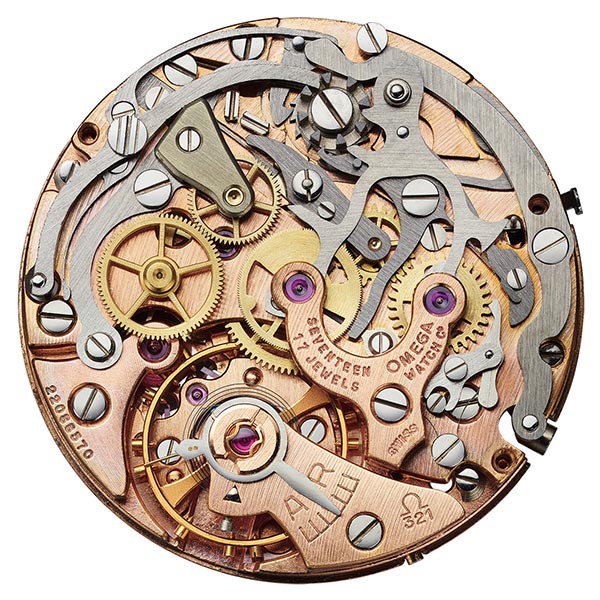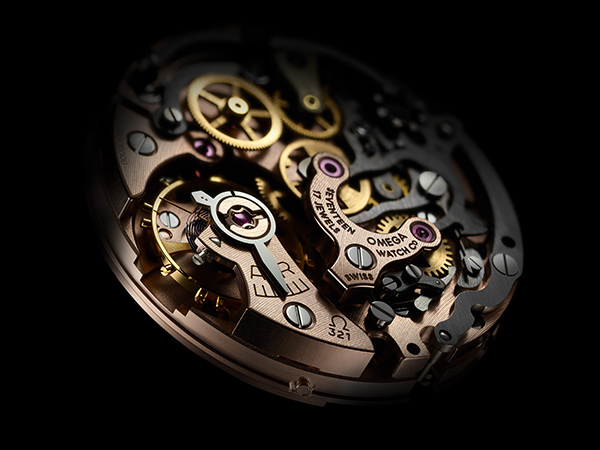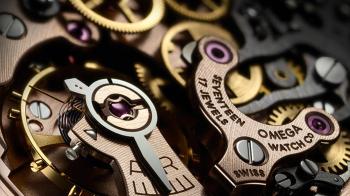Let’s go off-piste a little today and talk about the news that has got Omega fans talking but also raises a number of questions: it’s the recent announcement that the company will restart production of the legendary Calibre 321.
What exactly are we talking about?
Let’s go back to basics. A watch consists of a design, a dial, some hands, a case and a movement. There’s nothing special there. The success of a watch comes from a subtle and magical balance between all these elements, with a pinch of history, a sprinkle of marketing and a generous amount of opinion. In a nutshell, you either like it or you don’t. And since there is no accounting for taste or colour preferences, everyone can find something they like in the small world of watches.
But the movements – or calibres – have not always got the attention they deserved. Yet they are the beating heart of the watch. There are of course the famous grand complications, the kings of complexity, that break records and impress us with their innovation and their astronomical price tags. They are the horological equivalent of super cars to the general public. We take a look at them and talk about them, but few of us will ever have the chance of wearing them.
I have always preferred “democratic” watchmaking, where the greatest number of people can enjoy the beauty and functionality of a product. But there is a risk of falling into the category of watches with industrial movements that are too simple, too easy and not expensive enough. They are the junk food of the watch industry: mass produced products without a soul. They do the job, but don’t give you any pleasure.
But between these two extremes, there is hope…
Because watchmaking is not just about luxury goods. There was a time when a watch was a useful object and a reliable tool that had to fulfil an important role. To do so, it had to be reliable, easy to use and easy to repair. When utility was the main criterion, the movements used needed to be precise and capable of being produced in series. They thus became industrial objects derived from sophisticated craftsmanship. That is why I appreciate these innovative yet solid movements, with useful functions, that can be produced in large volumes. The list of such calibres is too long to mention here, but some of them are more famous than others, and for very different reasons. I have chosen eight.
The Zenith El Primero, which celebrates its 50th anniversary this year.
The Calibre 11 by the Chronomatic consortium (Heuer, Breitling, Buren), which is also 50 this year.
The Seiko 6139, which – funnily enough – is also 50 this year….
All of these movements were innovative and can rightly claim to be the first automatic chronograph in the world. They all deserve respect.
Other movements can be added to this list of stars. There is the Valjoux 72 calibre, which takes us back to the 1930s and which was produced until the mid 1970s, powering legendary watches such as the Rolex Daytona. And the Seiko 7a28 from 1980, the first analogue quartz chronograph, which is a superb piece of technology. More recently, there has been the Sistem 51 from Swatch, an ultra-simple automatic mechanical movement consisting of just 51 components, which is very easy to produce in large volumes. The list would not be complete without ETA’s workhorse, the 2824-2, which is found in innumerable watches. ETA, Heuer/Breitling, Valjoux, Seiko, Zenith and Swatch. The list is almost complete.
But there is another movement, the Lemania/Omega 321, which we will come back to shortly.
3,2,1 go!
Before taking a closer look at this movement, let’s try to understand why what we are looking at is so unique. A renowned brand, known for its innovations, decides to relaunch, in identical form, a movement that was first presented in 1946, 73 years ago.
In a world that is oriented towards progress, speed and constant improvement in human and technological performance, this is ground-breaking news.
If I add millennials and all new generations to come, the virtualisation of the economy and the digitalisation of information, how are we supposed to view this decision to bring back an object that is so “old”, so real and so mechanical?
It may seem illogical, but…
This is when we need to mention the realities of the watch industry. It is an industry that is currently torn between modernism and nostalgia.
Modernism is incarnated by the smart watch, which some people think doesn’t deserve to be called a watch. On the other hand, there is a wave of interpretations of historical models that is another major trend.
We should also not forget the increasingly “invasive” presence of vintage watches, which only strengthen the need for a link between the past and the present.
“Modern” watches are caught in a trap of innovation, new technologies and new developments. They are going to become ever more expensive and ever more difficult (as in all industries). Furthermore, new arrivals will continue to disrupt the market (like Apple today). And innovation creates the need for more innovation, so the customer has to follow this rhythm. But to do so, he or she has to be willing to accept the programmed obsolescence of their favourite products.
“Classic” watches are an entirely different thing. They can trade on the notion of time and nostalgia, dispensing with utilitarianism in favour of emotion, talking to our hearts rather than our heads.
In my view, this is what Omega is betting on.
Just imagine for a moment that Bugatti decides to relaunch its iconic Type 57 exactly as it was originally. Would it be an admission of defeat or an emotional success? Probably the latter.
With this relaunch, Omega acknowledges the fact that the watch has become an emotional item and it therefore needs a heart more than a brain. That will be the role of the Calibre 321.
Why the Calibre 321?
The 321 has a special place in watchmaking history.
Many of the above-mentioned movements have introduced technical innovations. They have changed the “technical” side of watches. The Lemania/Omega 321 didn’t necessarily do the same. So why is it so famous? Its legitimacy comes from elsewhere. From further away, or rather higher up.
The destiny of the 321 is linked to that of a watch, the Speedmaster. When it needed a watch for its astronauts, NASA secretly tested a number of different models. The Omega Speedmaster, originally intended for motorsport, was the lucky chosen one. And so the Moonwatch was born.
The calibre 321 powered the first Speedmasters.

When they were subjected to an entire barrage of tough tests, the 321 was their beating heart. When the first astronauts headed for the stars, they did so wearing Omega Speedmasters fitted with the Calibre 321.
So the 321’s reputation comes more from its use in space than its technical innovation. It is a genuine workhorse: it is solid, capable of withstanding shocks, temperature changes, accelerations, losses in pressure and intense vibrations.
But since progress always wins, Omega decided the change the movement in 1968 and move to a new generation that was easier – and cheaper – to produce. The 321 was dropped in favour of the Calibre 861, but space exploration continued.
For many years, nobody ever spoke about the 321 again. It was a time of change, of revolution. The past no longer mattered and only the future showed promise.
The same applied to watches.
Only recently, with the renewed interest in vintage watches, has the Calibre 321 been of interest. Nevertheless, Omega has always kept the Speedmaster in its catalogue, developing it at the risk of damaging its emotional appeal. The new movements, 861 and 1861 are not the “real thing”, the hard core that had created the legend. Even though they remain largely identical, they have lost a bit of their charm.

Like a Van Gogh painting or a rock star, the 321 only really became a legend after its demise. So everything here is about feelings.
Is the 321 better than today’s movements? No.
Is it more reliable? Probably not.
Is it easier to produce? Again, no. But it IS the 321.
You only need to start the chronograph on a modern Speedmaster and one on a 321 to notice the difference between the two: the (sweet) sound and (sweet) sensation of the 321 are still unique. And this is precisely what Omega has understood. Cold technology will never replace the magic of imperfection… With the return of the 321, Omega is not offering anything new. It is doing something even better: it is letting people travel back in time and dream.
And you cannot put a price on that.
What does the devil’s advocate think?
Whenever risks are taken, there is always room for the devil’s advocate.
The 321’s comeback raises a number of questions. Is this the end of innovation? Has watchmaking reached its limits? Or is it even the end of watchmaking history?
Fans of watchmaking “of the future” will not see this comeback as a good thing. There is no complication, nothing new, no new material and no new power source. Nothing.
But, in the face of such potential criticisms, Omega can respond that it is a highly innovative brand, as its more recent movements show. It is the very strength of the brand that it can appeal to both sides.
It can even find competitors to support it, like Zenith, which has never “abandoned” its El Primero, or Montblanc, which still produces exceptional watches powered by the Minerva calibres.
So, now what I am I going to do?
The announcement of the 321’s comeback made some noise. But it also raised some questions: Which watches? When? How? How many? How much? The best thing we can do now is wait. The announcement will come soon enough and we celebrate the 50th anniversary of the lunar landing in July this year. We will no doubt know more before then. So let’s be patient, the story is only just beginning.





